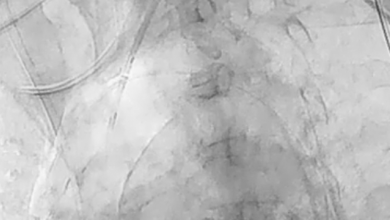Search results
PROMOTED
Author(s):
Nicolas M Van Mieghem
,
Kendra J Grubb
,
David Hildick-Smith
,
et al
Start date:
Mar 26, 2024
Author(s):
Inga Narbute
,
Sanda Jegere
,
Indulis Kumsars
,
et al
Added:
3 years ago
Coronary bifurcation disease is present in up to 15–20 % of lesions undergoing percutaneous coronary intervention (PCI) and remains one of the outstanding challenges of treatment with PCI.1,2 PCI for coronary bifurcations is associated with more procedural complications and higher restenosis and adverse event rates than lesions in the body of the vessel.3–7 The introduction of drug-eluting stents…
View more
Author(s):
Inga Narbute
,
Sanda Jegere
,
Indulis Kumsars
,
et al
Added:
3 years ago
Abstract
Together with calcified lesions, saphenous vein grafts, chronic total occlusions and unprotected left main lesions, bifurcation lesions are complex lesions that remain among the outstanding challenges of treatment with percutaneous coronary intervention. Bifurcation lesions are associated with increased rates of procedural complications, restenosis and adverse events than lesions in the…
View more
Author(s):
Leif Thuesen
,
Niels Ramsing Holm
Added:
3 years ago
Bifurcation lesions are frequent and account for about 15 % of all percutaneous coronary intervention cases.1 Bifurcations are a challenging lesion subset involving a main vessel (MV) and its side branch (SB). A bifurcation lesion may be looked upon as the proximal MV, the distal main vessel, the SB and the area of the bifurcation. Short- and long-term results depend on optimal handling of all…
View more
Author(s):
Tanush Gupta
,
Michael Weinreich
,
Mark Greenberg
,
et al
Added:
3 years ago
Percutaneous coronary intervention (PCI) is the most commonly used revascularisation modality for obstructive coronary artery disease.1 Despite significant advances in PCI over the past 40 years, severe coronary calcification remains a challenge for successful PCI.2,3 Up to 20% of patients undergoing PCI are estimated to have moderate to severe coronary calcification.4,5
Heavily calcified…
View more
Author(s):
Dariusz Jagielak
,
Radoslaw Targonski
,
Dariusz Ciecwierz
Added:
3 years ago
1. Interventional Cardiology Review 2021;16(Suppl 1):1–4. DOI:https://doi.org/10.15420/icr.2021.S1
View more
Author(s):
Nicolas M Van Mieghem
Start date:
Dec 08, 2015
During coronary revascularisation involving a main vessel and a side branch, it is unclear whether ballooning of the side branch is a prerequisite for long term clinical success. Coronary physiology techniques such as Fractional Flow Reserve (FFR) provide a unique way to scientifically quantify whether a side-branch may need revascularisation following treatment of the main vessel.
Frequently it…
View more
Author(s):
Sandeep Arunothayaraj
Added:
11 months ago
EuroPCR 23 —We are joined onsite by Dr Sandeep Arunothayaraj (University Hospitals Sussex NHS Foundation Trust, UK) to discuss the findings from a five-year follow-up of the EBC Two Trial. (NCT01560455)
EBC Two investigated single-stent versus dual-stent techniques in treating large bifurcation lesions. Over 200 patients were enrolled in the trial.The study found that routine culotte did not…
View more
Author(s):
Luca Longobardo
,
Alessio Mattesini
,
Serafina Valente
,
et al
Added:
3 years ago
Coronary artery bifurcation lesions are treated in 15–20% of percutaneous coronary intervention (PCI) procedures and are still plagued by worse outcomes.1 This is in spite of recent significant advancements in stent technology in general and in bifurcation stenting techniques in particular. Conventional angiography provides only limited information about bifurcation anatomy, plaque distribution…
View more
Author(s):
Maciej Lesiak
Added:
3 years ago
While provisional stenting has remained the preferred strategy for majority of bifurcation lesions, controversies still exist regarding when and how to use complex techniques. Most of randomised studies comparing simple and complex approaches have focused on selected populations, included both ‘true’ and ‘non-true’ bifurcation lesions, used first-generation drug eluting stents (DES) and favoured…
View more
















